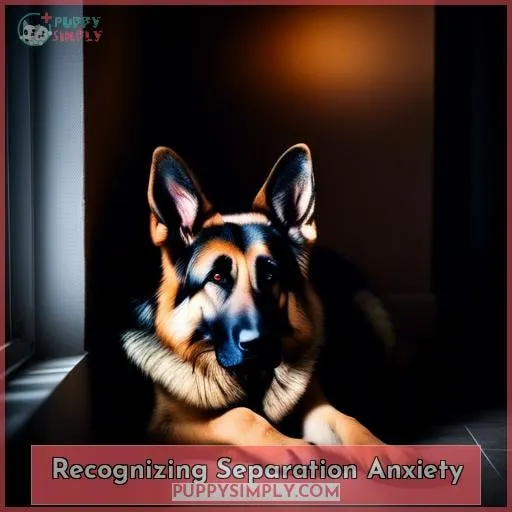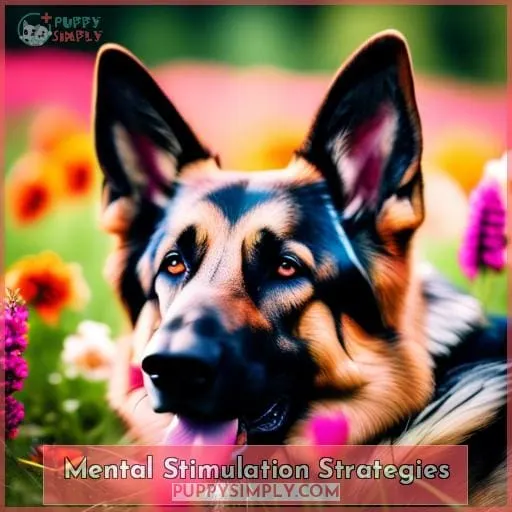This site is supported by our readers. We may earn a commission, at no cost to you, if you purchase through links.

Engage in positive reinforcement and regular, stimulating activities to channel their vigor constructively.
With patience and consistency, you’ll foster a serene companion, adept at finding peace amidst excitement.
Let’s explore how to get your German Shepherd to calm down with effective training and exercise tips.
Yes, German Shepherds can be trained to calm down by employing positive reinforcement and ensuring they receive ample exercise and mental stimulation. Establishing a consistent routine and providing a quiet space for relaxation are also effective strategies.
Table Of Contents
- Key Takeaways
- German Shepherd Genetics
- Recognizing Separation Anxiety
- Positive Reinforcement Training
- Crate Training Essentials
- Regular Exercise Benefits
- Enhances Mental Health
- Regular exercise not only benefits the physical health of German Shepherds but also plays a crucial role in enhancing their mental health. Activities such as walking
- running
- and playing fetch can help reduce anxiety and stress
- making them calmer and more relaxed.
- Prevents Destructive Behavior
- A well-exercised German Shepherd is less likely to engage in destructive behaviors. Lack of exercise can lead to boredom and frustration
- which often manifest as chewing
- digging
- or excessive barking. Incorporating daily physical activities can significantly mitigate these issues.
- Strengthens Owner-Dog Bond
- Engaging in regular exercise routines with your German Shepherd strengthens the bond between you and your dog. Activities that require teamwork and communication
- such as agility training or herding exercises
- enhance trust and mutual respect
- Managing High Energy
- Calming Through Obedience
- The Capture Method Explained
- Go Crazy and Stop Technique
- Mental Stimulation Strategies
- Frequently Asked Questions (FAQs)
- How can I help my German Shepherd cope with thunderstorms or fireworks, as they seem to exacerbate his anxiety?
- Are there specific dietary considerations that could help reduce hyperactivity in German Shepherds?
- What are the signs that my German Shepherd might need professional behavioral therapy for anxiety issues?
- How can I safely introduce my German Shepherd to new pets or children to minimize stress and anxiety?
- Can alternative therapies such as acupuncture or aromatherapy be effective in calming an anxious German Shepherd?
- Conclusion
Key Takeaways
- Utilize positive reinforcement training to reward and encourage calm behavior in German Shepherds, as it builds confidence and reduces anxiety.
- Provide regular exercise and mental stimulation to manage their high energy levels, which in turn can prevent destructive behavior and promote relaxation.
- Establish a routine that includes both physical and mental activities to channel a German Shepherd’s vigor constructively and maintain a harmonious home environment.
- Practice obedience exercises to manage excitement and teach self-control, using techniques like Go Crazy and Stop to help German Shepherds learn to calm down on command.
German Shepherd Genetics
Bearing in mind the complex interplay of genetics in shaping the behavior and physical traits of German Shepherds, you’ll find that their genetic makeup is a rich tapestry that influences everything from their temperament to their physical health.
Genetic variability within the breed has been shaped by selective breeding, which has emphasized certain breed characteristics and hereditary traits. This process of canine evolution has been both a boon and a bane, as it has led to the development of a loyal and intelligent breed, but also to certain health issues and behavioral tendencies like separation anxiety and potential for destructive behavior.
The calming of a German Shepherd, therefore, isn’t just about managing its environment but also understanding its genetic predispositions. Training and mental stimulation are key in addressing the breed’s high energy levels and preventing destructive behavior.
By recognizing the hereditary traits that contribute to their behavior, you can tailor your approach to their training, ensuring that they receive the mental stimulation they need to be well-balanced.
Remember, a calm German Shepherd is one that has been well-exercised, properly trained, and mentally engaged.
Recognizing Separation Anxiety
Recognizing the signs of separation anxiety in your German Shepherd is essential, as this breed’s strong attachment to their owners can often lead to such distress when left alone. If you notice your furry companion exhibiting behaviors like excessive panting, shaking, pacing, drooling, or aggression, these could be indicators of separation anxiety.
It’s important to understand your dog’s behavioral patterns and recognize triggers that may cause anxiety. Implementing training techniques and environmental modifications can help manage these symptoms.
Establishing a consistent routine, including regular exercise, can be beneficial. Activities like sniffing games and chewing on appropriate toys can also serve as coping mechanisms.
By being patient and attentive, you can help your German Shepherd feel more secure, even when you’re not around. Remember, managing separation anxiety is a gradual process that may require a combination of strategies for improvement.
Positive Reinforcement Training
After recognizing signs of separation anxiety, you’ll find that one of the most effective ways to calm your German Shepherd is through positive reinforcement training. This method focuses on rewarding desired behaviors, which encourages your dog to repeat them.
- Reward Techniques: Use treats or praise to reward your dog immediately after they display calm behavior. This reinforces the action you want to see more of.
- Behavior Modification: Gradually increase the challenges, starting with simple crate and leash training, to build confidence and reduce anxiety.
- Reinforcement Strategies: Consistency is key. Regularly practicing these training approaches ensures your German Shepherd understands what’s expected, leading to a calmer and more obedient companion.
By employing these encouragement methods, you’ll effectively calm down your German Shepherd, fostering a serene and happy home environment.
Crate Training Essentials
Building on the foundation of positive reinforcement training, crate training is an essential tool for managing your German Shepherd’s anxiety and ensuring their safety. Choosing the right crate is the first step; it should be a sanctuary, not a prison.
Introduce the crate gradually, making it a positive experience with treats and praise. Consistency is key—use the same command for entering the crate and offer a reward once inside. As a working dog, your German Shepherd may find solace in the crate’s den-like atmosphere, helping them calm down and feel secure.
| Crate Training Essentials | Emotional Benefit | Practical Benefit |
|---|---|---|
| Choosing the right crate | Security | Safety |
| Gradual introduction | Trust | Adaptability |
| Positive reinforcement | Confidence | Obedience |
| Consistent commands | Understanding | Routine |
| Rewarding calm behavior | Calmness | Emotional support |
Regular Exercise Benefits
Regular exercise is key to maintaining your German Shepherd’s mental and physical health. It helps mitigate their natural high energy levels, preventing destructive behaviors born from boredom and frustration.
By incorporating daily physical activities, you’ll also strengthen your bond, building trust and mutual respect through teamwork and communication.
Enhances Mental Health
Beyond the physical benefits, incorporating regular exercise into your German Shepherd’s routine significantly enhances their mental health.
- Enhanced focus and stress reduction during running sessions.
- Cognitive enrichment through new environments, promoting emotional balance.
- Behavioral improvement, reducing anxiety-related issues without needing a herbal supplement, service dog, or pheromone diffuser.
This approach fosters a sense of safety, control, and understanding, crucial for a harmonious relationship.
Regular exercise not only benefits the physical health of German Shepherds but also plays a crucial role in enhancing their mental health. Activities such as walking
Numerous activities, such as walking and playing fetch, not only maintain your German Shepherd’s physical health but also significantly enhance their mental well-being.
Regular exercise acts as a cognitive workout, reducing anxiety and sharpening their minds.
Incorporate interactive toys and enrichment activities into their routine to boost mental stimulation benefits, ensuring a well-balanced and content companion.
running
Running is an essential component of a German Shepherd’s exercise regimen, offering significant benefits for both their physical and mental well-being.
- Treadmill Training: Ideal for controlled pace and endurance, enhancing energy management.
- Trail Running: Stimulates their senses and mimics natural environments, improving behavior.
- Sprint Intervals: Boosts cardiovascular health and acts as an anti-anxiety supplement.
- Canicross Races/Beach Sprints: Strengthens the bond, serving as a comfort cuddler buddy for your semantic German Shepherd.
and playing fetch can help reduce anxiety and stress
Playing fetch with your German Shepherd not only helps in reducing their anxiety and stress but also serves as a continuation of the running and other aerobic exercises that are vital for their well-being.
This playful interaction acts as exercise therapy, offering stress relief and anxiety reduction.
It’s especially beneficial for hyper dogs or those with travel anxiety, turning the family dog into a calmer companion.
making them calmer and more relaxed.
By incorporating regular exercise into your daily routine, you’ll notice your German Shepherd becoming calmer and more relaxed, as physical activity helps to alleviate anxiety and stress.
Try implementing deep breathing techniques, mindfulness exercises, relaxation techniques, visual imagery methods, and progressive muscle relaxation to help your German Shepherd remain composed.
Sound anxiety CDs, hemp oil, heartbeat puppy toys, nose work, and Petlsi German Shepherd chew toys can also promote relaxation.
Prevents Destructive Behavior
With regular exercise, you’re directly addressing one of the primary causes of destructive behavior in German Shepherds: their high energy levels and need for mental stimulation.
Engaging them in behavioral enrichment activities like interactive toys and puzzle games can prevent boredom. Teaching new tricks or providing environmental enrichment ensures their minds are as active as their bodies, curbing unwanted chewing or digging.
A well-exercised German Shepherd is less likely to engage in destructive behaviors. Lack of exercise can lead to boredom and frustration
In light of the importance of regular exercise for your German Shepherd to prevent boredom and frustration, incorporating a variety of activities into their routine is essential.
- Mental Stimulation: Engage their minds with cognitive challenges.
- Behavioral Enrichment: Use interactive toys for indoor and outdoor play.
- Environmental Exploration: Encourage sniffing and exploring on walks to satisfy their curiosity.
which often manifest as chewing
Carrying over from the previous discussion on the importance of exercise for preventing boredom and frustration in German Shepherds, you’ll find that these feelings often spill over into destructive behaviors like chewing.
| Strategy | Benefit |
|---|---|
| Chewing Prevention | Reduces unwanted gnawing |
| Behavioral Redirection | Focuses energy positively |
| Mental Stimulation | Engages the mind |
Incorporating Interactive Toys and Distractive Activities can significantly mitigate these issues, ensuring your dog’s well-being.
digging
You’ll notice that a German Shepherd with ample exercise is less likely to resort to digging as an outlet for their pent-up energy. By focusing on soil enrichment and burrow prevention, you can guide their curiosity in healthier directions.
Landscaping solutions and behavioral redirection play key roles. Incorporating environmental enrichment into their routine transforms destructive habits into positive behaviors, ensuring a harmonious home environment.
or excessive barking. Incorporating daily physical activities can significantly mitigate these issues.
Incorporating daily physical activities for your German Shepherd can significantly reduce excessive barking and other destructive behaviors.
Engage your dog in mental stimulation techniques and relaxation exercises to promote stress reduction.
Environmental enrichment and behavioral modification are key; they redirect energy positively and foster a serene atmosphere.
Consistent practice of these strategies will enhance your control and understanding, ensuring a calmer companion.
Strengthens Owner-Dog Bond
Engaging in regular exercise with your German Shepherd not only mitigates destructive behaviors but also significantly strengthens your bond with them.
- Bonding activities like agility training involve teamwork and build trust.
- Trust-building games enhance mutual respect and understanding.
- Interactive playtime, such as fetch, keeps you both engaged and connected.
- Teamwork exercises and communication drills improve your cooperative relationship.
Engaging in regular exercise routines with your German Shepherd strengthens the bond between you and your dog. Activities that require teamwork and communication
Building on the importance of regular exercise for your German Shepherd’s mental health, engaging in activities that require teamwork and communication will further strengthen the bond between you and your dog.
Teamwork benefits shine through in agility training, where trust building and bond strengthening are key.
Communication exercises enhance mutual understanding, ensuring a deeper connection and a happier, more obedient companion.
such as agility training or herding exercises
In continuation with the bonding activities that enhance your relationship with your German Shepherd, agility training and herding exercises offer dynamic ways to engage your dog’s natural instincts and provide both physical and mental stimulation.
- Agility Challenges: Test your dog’s speed and agility through obstacle courses.
- Herding Competitions: Mimic traditional herding tasks to stimulate their herding instincts.
- Training Techniques: Use positive reinforcement to teach skills and build a stronger bond.
enhance trust and mutual respect
A well-structured exercise routine not only keeps your German Shepherd physically fit but also significantly enhances the trust and mutual respect between you and your dog.
Engage in trust-building exercises and use communication techniques during play.
Bonding activities like agility foster mutual understanding, while respect training ensures a harmonious relationship.
These efforts culminate in a deep, unspoken bond.
Managing High Energy
After enhancing their mental health through regular exercise, you’ll need to manage your German Shepherd’s high energy levels by establishing a routine consisting of both physical and mental stimulation.
Engage your energetic companion in activities that channel their vigor constructively. Consider the innovative Copenhagen wheel, which can transform your bike into an electric one, allowing for longer rides that your German Shepherd can run alongside, fulfilling both health and fitness needs.
Test ride this electric bike conversion system to ensure it’s a good fit for your lifestyle.
This balanced approach will help mitigate any potential for destructive behavior and maintain a harmonious environment at home.
Calming Through Obedience
To effectively calm your German Shepherd through obedience, you’ll need to consistently practice obedience exercises amidst distractions, fostering self-control and focus. This approach not only enhances their mental focus but also strengthens the bond between you and your dog.
- Training Consistency: Regular sessions reinforce desired behaviors, making calmness a habit rather than an exception.
- Behavioral Corrections: Immediate, gentle corrections guide them towards the right actions, building a clear line of communication.
- Bonding Exercises: Activities that require teamwork, like agility or fetch, deepen your connection, making obedience a shared goal rather than a demand.
By integrating these elements, you’ll cultivate a serene and obedient companion, ensuring safety and harmony in your home.
The Capture Method Explained
You’ll master the capture method, a training technique that rewards your German Shepherd’s calm behavior, by keeping treats handy and acknowledging their tranquility as it occurs. This approach is rooted in reward reinforcement, subtly guiding your dog towards desired behaviors through positive acknowledgment.
It’s a cornerstone of behavioral modification, emphasizing the importance of recognizing and reinforcing moments of canine relaxation.
Consistency in this training method is key, as it builds a clear association between calm behavior and positive outcomes, effectively aiding in anxiety alleviation.
By integrating this strategy into your daily interactions, you’ll not only foster a more serene environment but also strengthen the bond between you and your German Shepherd, ensuring a mutual understanding and respect that underpins a harmonious relationship.
Go Crazy and Stop Technique
Starting with a burst of energy, you’ll excite your German Shepherd using playful actions like jumping or clapping, then abruptly command Stop! and freeze to teach them the Go Crazy and Stop Technique.
- Excitement management: Quickly switch from high energy to complete stillness, helping your dog learn to control their excitement.
- Behavioral control: This technique teaches your dog that calm behavior is rewarded, reinforcing good manners.
- Arousal regulation: Helps your dog understand how to regulate their arousal levels, preventing overexcitement.
- Impulse inhibition: Encourages your German Shepherd to pause and think before acting, enhancing their impulse control.
- Command mastery: Strengthens your dog’s obedience to commands, even in the midst of excitement, ensuring they listen under any circumstances.
Mental Stimulation Strategies
After exploring the Go Crazy and Stop technique, it’s essential to delve into mental stimulation strategies to further engage your German Shepherd’s mind. Engaging in brain games and mental exercises is a fantastic way to keep your dog mentally sharp and prevent boredom.
These activities not only provide entertainment but also enhance problem-solving skills, making your German Shepherd more adaptable and intelligent. By incorporating mental stimulation into your daily routine, you’re ensuring a well-rounded approach to your dog’s health and happiness, fostering a stronger bond between you and your furry friend.
Introduce puzzle toys and enrichment activities into playtime to challenge their intellect. Interactive challenges and cognitive exercises, like teaching new tricks or hide-and-seek, can significantly improve their mental agility.
Frequently Asked Questions (FAQs)
How can I help my German Shepherd cope with thunderstorms or fireworks, as they seem to exacerbate his anxiety?
To help your German Shepherd cope with thunderstorms or fireworks, create a safe space where the noise is muffled.
Use calming music or white noise, and stay calm to reassure them.
Consistent training and patience are key.
Are there specific dietary considerations that could help reduce hyperactivity in German Shepherds?
To help reduce hyperactivity in German Shepherds, consider a balanced diet with high-quality proteins, fats, and slow-release carbohydrates.
Avoid high-carb foods, artificial additives, and low-quality ingredients. Fresh dog food with whole ingredients is ideal.
What are the signs that my German Shepherd might need professional behavioral therapy for anxiety issues?
If your German Shepherd’s anxiety turns into a storm, tearing through the calm of your home with behaviors like aggression, self-harm, or destruction, it’s time to seek shelter in professional help.
These signs indicate a tempest too severe for home remedies alone. Beyond the occasional thunderclap of fear, such behaviors require attention from someone trained to manage canine behavioral issues.
How can I safely introduce my German Shepherd to new pets or children to minimize stress and anxiety?
To safely introduce your German Shepherd to new pets or children, start with controlled, calm encounters in a neutral space. Ensure both the dog and the new family member are relaxed, using treats and praise to reinforce positive interactions.
Gradually increase their time together, always supervising to prevent misunderstandings. Teach children to respect the dog’s space and avoid rough play, ensuring a harmonious relationship develops.
Can alternative therapies such as acupuncture or aromatherapy be effective in calming an anxious German Shepherd?
Alternative therapies like acupuncture and aromatherapy may help calm an anxious German Shepherd. It’s essential to consult your vet first and consider each dog’s individual response.
Conclusion
Just like you’ve mastered the art of unwinding after a long day, your German Shepherd can too.
With the right mix of positive reinforcement, structured crate training, and ample exercise, you’ll see a remarkable difference in their energy levels.
Keep up the mental stimulation and the shared activities, and you’ll nurture a peaceful, obedient companion who’s a joy to be around.
















